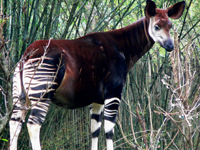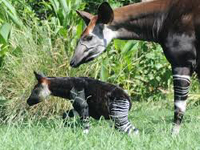

 |

|
 Okapi |
Okapi(Mammal) |
 Okapi Baby |
Okapi HabitsActive by day, the okapi prefers the pathways of those areas of forest where the growth is thick and lush, but not where the forest canopy is dense. It also inhabits large clearings in forest and bush regions, especially where water is close by.
The okapi has glands between its hooves that secrete a scented substance, used to mark its range. It has also been observed spraying bushes with urine. The okapi is not very territorial, although it does establish its own sleeping and resting areas.
Within its habitat, the okapi's only natural enemy is the leopard. If confronted by a leopard, the normally peaceful okapi will lash out with its hooves in defense. Illegal hunting by local tribesmen is also a threat to the okapi.
The okapi first became known to the scientific community through the British explorer Sir Harry Johnston at the turn of the century. African pygmy tribesmen brought him part of an okapi skin, which the Zoo-logical Society of London later examined. They classified the animal as Equus johnstoni-Johnston's horse. It was only later, when a complete skin and some bones were examined, that is was found that the okapi was not, in fact, related to the horse.
In its native habitat the okapi is wary and elusive:its acute hearing provides early warning of danger, and its effective camouflage enables it to move about in the wild undetected by man. Therefore, most knowledge about the okapi has been learned by observing it in zoos. |
Okapi CommunicationTo us, okapi communication is invisible. In an environment thick with predators and alive with dense trees that make it impossible to see more than a few feet in any direction, okapi communicate using glands between their toes to leave trails of smell wherever they walk. They make sounds so low that humans cannot hear them, called infrasonic communication. |
Okapi BreedingOkapis are usually solitary animals; the males and females come together only to mate. Scientists believe that a female shows her readiness to mate by marking an area with urine.
A male attracts a female by curling his lip and by tossing his head to show off his white throat. At first the female responds aggressively to his attentions, but she eventually mates with him.
Most births occur during the period of maximum rainfall, when there are plenty of new shoots for the mother and young to eat. The female retreats deep into the forest to give birth.
The single young okapi is able to stand and suckle from its mother within 6 to 12 hours of birth. At this stage, the young okapi barely resembles its parents. In proportion, its head is smaller, its neck is shorter, and its legs are thicker and longer.
The femals okapi is very protective of her offspring. In her natural habitat, she hides the youngster in the forest, returning at regular intervals, guided by its bleating calls.
The young okapi begins to browse, or graze, at six weeks but continues to suckle for at lease six months and does not become fully independent until it is nine months old. |
Okapi Food & FeedingThe okapi is a browser, or grazer, and its favorite food is young shoots of forest plants. It also eats leaves, seeds, fruit, and some grasses and ferns.
It feeds by grasping branches with its long tongue and stripping off the shoots, leasves, and fruit. Like the giraffe, the okapi has lobed canine teeth that are a special adaptation; they help it strip the leaves from trees.
The okapi cannot jump or support itself on its hind legs to reach high into the trees to feed. Still, its neck, although much shorter than that of a giraffe, is extremely supple. With the use of its neck and long tongue, the okapi can reach branches 10 feet above the ground. |
Okapi Key Facts |
| Size |
| Height: 5 feet. Length: 6-7 ft. |
| Weight: 450-550 pounds |
| Breeding |
| Sexual maturity: Females, from 19 months. Males, later |
| Mating: Usually May-June or November-December, but can occur anytime |
| Gestation: 14-16 months |
| Number of young: 1 |
| Lifestyle |
| Habit: Solitary, or small temporary groups |
| Diet: Leaves, fruit, and seeds |
| Lifespan: Oldest captive, 33 years |
DID YOU KNOW?
|
CAN'T FIND WHAT YOU'RE LOOKING FOR? CLICK HERE!!!